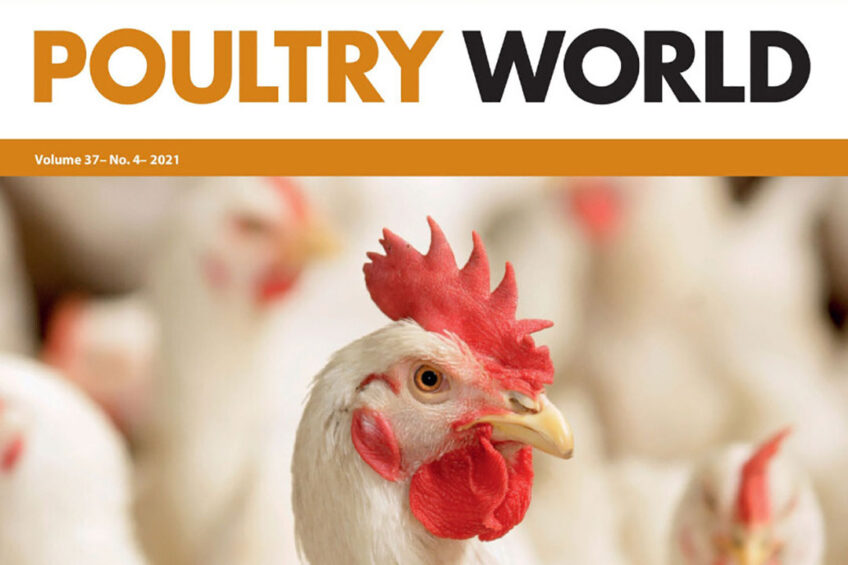Poultry World edition 4 of 2021 is now online

This edition of Poultry World looks into driving sustainability through transparency, enabled by the creation of the first-ever full supply chain sustainability reporting framework. Then, as the EU pledges to reduce the use of livestock antibiotics, analysis shows that different member states have had drastically different trajectories towards achieving this goal. Also, a study reveals that hens have a strong preference for wooden nests.
View Poultry World’s digital magazine
Driving sustainability through transparency
Ryan Bennet, executive director at US Roundtable for Sustainable Poultry & Eggs, comments on the creation of the first-ever full supply chain sustainability reporting framework. The article delves into how to create a common language, common metrics and common indicators throughout the entire value chain in a way that builds trust for all stakeholders.
FreeBirds project advances organic production
Poultry World reports on some of the conclusions highlighted by Valentina Ferrante, senior poultry researcher at the University of Milan, following his study into soil organic matter and nutrient levels in different organic poultry runs – a particularly relevant study given the drive of the European Commission’s Farm to Fork strategy.

View Poultry World’s digital magazine
The value of fish silage for broilers
Researchers from the University of Nayarit in Mexico conducted a study to investigate the nutritional value of fish silage in terms of growth performance and meat quality in broilers. The study explores how fish silage can reduce waste and environmental pollution, while providing a good source of essential amino acids and minerals.

Botanical vitamin D tailored for high performance
Vitamin D is an essential micronutrient for livestock, but sufficient levels can be compromised in commercially-raised poultry due to a limited exposure to UV light. Although supplementing through feed can be effective, a targeted approach is required to ensure that vitamin D is metabolised with endogenous enzymes.

View Poultry World’s digital magazine
Antibiotic reduction in the EU progressing at different speeds
As the EU pledges to reduce the use of livestock antibiotics, analysis shows that different member states have had drastically different trajectories towards achieving this goal. A closer look at the Netherlands and Spain shows the importance of close cooperation between governments and industries.

Relying on soybean meal alone can be risky
Researchers in the UK are conducting trials for soybean meal replacements in poultry rations through optimising other protein sources. One new initiative involves recycling industrial carbon dioxide into cost-competitive protein for high value, sustainable animal feed, and another initiative is a bioethanol protein concentrate project.

View Poultry World’s digital magazine
Ensuring water quality in poultry production
Poultry scientist, Brian Fairchild, shares his expertise on water quality and management in poultry production. This article also offers insights into the results from researcher Sharon Mae’s PhD thesis on new tools being used to suppress undesirable bacteria in biofilms.

Flexible poultry processing increases yields
A significant trend adding to the challenges faced by poultry processors, particularly in Western Europe, is the variation in breeds and weights within and between flocks. This article looks at the importance of a flexible solution which offers efficient processing and maximum yields.

View Poultry World’s digital magazine
Broiler breeders prefer wooden nests
This article reviews the results from a study focusing on nesting preferences in which hens were given the choice of 4 nest box designs. The research reveals a strong preference for wooden nests and examines how the provision of these nests can contribute to an increased number of eggs laid whilst reducing the number of floor eggs.

Beneficial dietary fibre in laying hens
Following an experiment conducted on 72 brown laying hens of various ages, a study finds that it is necessary to provide fermentable dietary fibre as a nutritional basis for gut bacteria and that doing so can positively influence egg production and feed conversion of hens in the laying phase.

View Poultry World’s digital magazine
Controlling Gumboro consistently
The significance of controlling Gumboro disease, by way of vaccination, is that it maintains the consistency of broiler production, protecting against clinical and sub-clinical infection, thus ensuring the uniformity of the results in the field and at processing.

Boosting gut integrity with a good source of charcoal
As the use of permitted pharmaceutical solutions to control infections is being increasingly restricted, other more natural strategies are being perused. One such solution is a quality source of charcoal which has shown to effectively support and improve gut integrity.

View Poultry World’s digital magazine
Insights and alert for the southern hemisphere
Dr David E. Swayne at the USDA offers insight and advise to poultry sectors in the southern hemisphere. He discusses what makes the H5 avian influenza virus different to previous strains, and how outbreaks have affected the poultry industry in Europe and Asia.

Effects of anti-microbial interventions during the slaughter process
Researchers have conducted a study to better understand how varying pH levels of the chemical peroxy acetic can reduce the risk cross contamination risk of Salmonella, Campylobacter and Escherichia coli during the slaughter process.

To access the magazine section, where you will find the 4th edition of Poultry World 2021 as well as other magazines from specialists in the agriculture industry, simply register for free.












